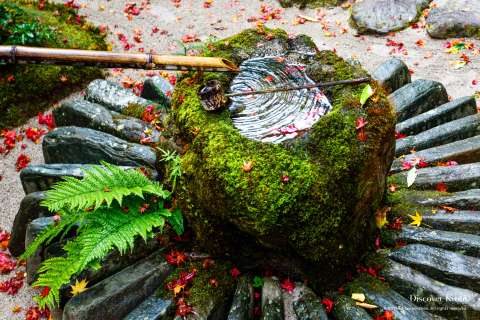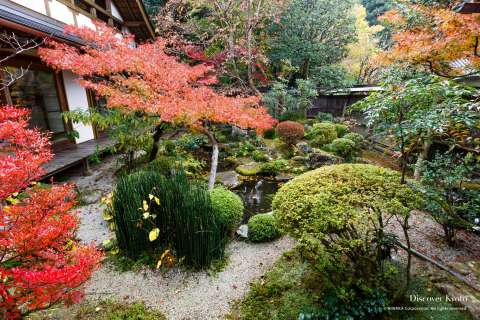Hōsen-in|宝泉院
Overview

Founded eight hundred years ago in affiliation with the nearby Shōrin-in, Hōsen-in is a small temple that boasts two gorgeous gardens and fascinating architectural points throughout its grounds. Upon entering the temple you will catch sight of the top of a large pine tree shaped to resemble the iconic Mt. Ōmi-Fuji, a main feature in the two-sided framed garden viewable from within. Visitors are served green tea and a sweet, and taking a seat to enjoy the garden while sipping tea can be a good chance to de-stress. Interestingly enough, the ceiling of this hall was constructed using the oily, bloody floorboards of a castle where a large ritual suicide took place in order to pacify the lost souls. Another point of interest is the water basin in the right corner of the veranda where two bamboo poles stick out of the wooden boards. Put your ear to one of the poles and enjoy the melodic sound created by water in cleverly constructed dripping basins beneath your feet. Just inside the temple gate and down some steps is another garden, the Hōraku-en. Featuring a stone bridge and interesting stonework shapes, it’s a quaint way to finish up your visit to Hōsen-in.
Visitors are served green tea and a sweet, and taking a seat to enjoy the garden while sipping tea can be a good chance to de-stress.
Features
Bloody Ceilings
More than four hundred years ago a great battle took place at Fushimi Castle, where Torii Mototada defended the fortress through an eleven day siege against superior numbers in order to buy time for his lord Tokugawa Ieyasu to gather his forces. Outnumbered and about to lose the castle, Torii and his remaining soldiers gathered in the main keep and committed ritual suicide rather than be captured by the enemy. After the incident the blood and oil-stained floorboards were installed as the ceiling in certain Kyoto temples in order to host memorial services for the fallen, Hōsen-in being one of them. Though the halls of Hōsen-in are somewhat dark, look up if you dare.
Suikinkutsu
Shōmyō, a musical form of Buddhist chanting, is widespread in Ōhara, and the focus on music and sound has created something charming in the garden of Hōsen-in. An earthen jar is filled with small pebbles, and two bamboo pipes stick up from this jar through the veranda floorboards. As water drips down in to the jar and the drops hit the stones, the echoing chimes can be heard if you put your ear to the bamboo.
Goyo no Matsu

Said to be 700 years old, this elderly pine tree is carefully pruned into the shape of Mt. Ōmi-Fuji and can be seen in this form the moment you enter the gate of Hōsen-in. From within the hall the pine’s lower branches, supported by beams, take up one side of the temple’s lovely framed gardens. While looking at the pine you will be served a cup of matcha (green tea) along with a small original sweet that you can enjoy while taking in the garden’s beauty.
Hōraku-en Garden

South of the large Goyo no Matsu is the Hōraku-en. Visitors to the garden descend into it via large stones and ascend out at the exit in the same manner. The bottom level of the garden features interesting raked gravel patterns, a pillar of sand, a water basin, and a swirl of rock slabs around mossy stone. Camellias planted in the garden dot the greys and greens with colorful red once the heavy flowers begin to drop.
History
Hōsen-in originally served as priest’s quarters for the nearby Tendai sect temple of Shōrin-in, built in 1013, which was known for its practice of musical Buddhist chanting known as shōmyō. Its current architectural style dates to the Muromachi Period, with actual buildings believed to have been reconstructed in the Edo Period.
Access
Address
〒601-1241 京都市左京区大原勝林院町187番地
| TEL | 705-744-2409 |
| WEB | http://www.hosenin.net |
Admission
- General Admission: ¥800 (includes tea and sweet)
Hours
- General Admission: 09:00 – 17:00 (last entrance 16:30)
- Closed: No closing days
Transportation
- Karasuma Subway Line ⇒ Kokusaikaikan Station ⇒ Kyoto Bus Route 19 ⇒ Ōhara Bus Stop ⇒ 7 minutes walking
- From Kyoto Station ⇒ Kyoto Bus Route 17 ⇒ Ōhara Bus Stop ⇒ 7 minutes walking
Gallery
-




 +27
+27
